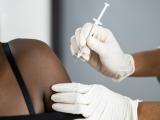July 1, 2002 (CIDRAP News) – About half of the nation's supply of anthrax vaccine—previously dedicated almost entirely to military use—will henceforward be set aside for civilian use in the event of another anthrax attack, federal defense and health officials announced Jun 28.
The military will not return any time soon to its former goal of anthrax vaccination for all military personnel, according to the announcement by the Department of Defense (DoD) and Department of Health and Human Services (HHS).
DoD launched a program in 1998 to vaccinate all troops, but when the vaccine supply ran short in 2000 because of production difficulties, the program was limited to personnel considered to be at highest risk. Now the department will expand the program again, but it will still be limited to troops in "high-threat" parts of the world, officials said. They cited the still-limited—though improving—supply of vaccine and the possible civilian need for it as reasons not to return to universal military vaccination.
Deputy Secretary of Defense Paul Wolfowitz stated in a news release, "Given the deadly events of last fall and what we know of the threat of anthrax as a bioweapon, we are taking action to provide protection to those servicemembers who are at greatest risk, and also to share available vaccine supplies with the Department of Health and Human Services and other federal agencies to address possible domestic use situations. This policy coordinates and balances both civil and military needs."
The military vaccination program now will focus on "service members, essential civilians, and contractor personnel who are assigned or deployed for more than 15 days in higher-threat areas of the world, whose performance is essential for certain mission-critical capabilities," said Dr. William Winkerwerder, assistant secretary of defense for health affairs. Speaking at a Jun 28 news conference, he said the shots will be mandatory.
He did not reveal how many people would be vaccinated or what areas are in the high-threat category. A Jun 29 report in the New York Times, quoting unnamed DoD officials, mentioned Persian Gulf countries, the Korean peninsula, and possibly Afghanistan as the areas involved.
Winkenwerder said DoD expects that "roughly half" of the vaccine supply will be stockpiled for possible civilian use, though that could change depending on "threat conditions." In case of another anthrax episode, the vaccine would be offered to potentially exposed people. "The purpose of having a civilian stockpile that is consistent with the DoD force protection requirements is for a post-exposure situation," he said. "But were we to have a situation of an anthrax exposure, we would offer the combination of vaccine and antibiotics."
A DoD announcement on the anthrax vaccination program had been awaited since Jan 31, when the nation's only manufacturer of the vaccine was cleared to begin distributing the vaccine after about a 3-year delay. BioPort Corp. bought the anthrax vaccine plant from the state of Michigan in 1998 and subsequently renovated it. The company worked from the time of the purchase until last January to obtain Food and Drug Administration (FDA) approval to produce and distribute the vaccine. The delay in gaining FDA approval led to the vaccine shortage that forced the Pentagon to reduce the vaccination program in 2000. The vaccine itself was licensed by the FDA in 1970.
Winkenwerder said BioPort is producing "hundreds of thousands of doses on roughly a monthly basis." But because the vaccine as currently used requires six doses over 18 months plus annual boosters, the supply remains limited, he said. About 2.2 million doses of vaccine have been given to roughly 550,000 people in the Pentagon program so far, he reported.
When he was asked why DoD is not resuming "total force" vaccination, Winkenwerder said, "The first [factor] is that we are dealing in a constrained supply situation. And two, we now have the potential need for use of a vaccine in a domestic or civilian situation."
Service members who received only part of the vaccination series before the program was curtailed will receive the rest of the series even if they are not going to a high-risk area, Winkenwerder said. The FDA requires that the full series be given.
For personnel being vaccinated for the first time, he said, the "possible intent" is to start the series at least 45 days before they go overseas so that they will have at least three doses before they leave. Three doses are enough to induce a "fairly significant level of immunity," he said.
The Pentagon news release said that HHS, DoD, and other federal agencies are working to develop a new anthrax vaccine that will offer "a more user-friendly regimen" than the current vaccine's six-shot sequence. "Currently, there has been strong interest from industry to develop and produce an improved vaccine, requiring fewer doses, in just a few years," the statement said.
At the press conference, William F. Raub, PhD, deputy director of the federal Office of Public Health Preparedness, said the National Institutes of Health is working to develop a "cell-culture-based vaccine based on recombinant technology." That technology would permit rapid production of "almost indefinitely large quantities of vaccine," he said.
Meanwhile, the Centers for Disease Control and Prevention plans to test whether the existing vaccine can be given in fewer doses and still be effective, Raub said.
Several hundred military personnel have refused to take the anthrax vaccine series because of concern about side effects. An Institute of Medicine committee reported last March that the vaccine is safe but called for a new vaccine that would require fewer doses and cause fewer side effects.




















